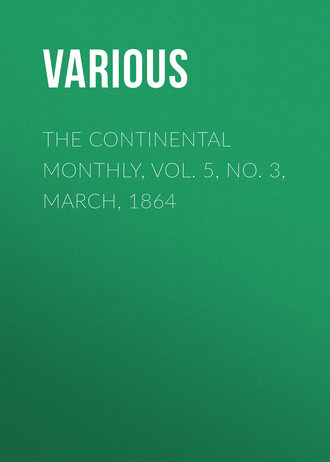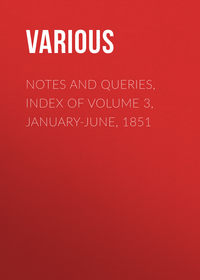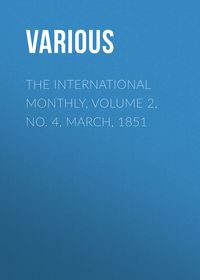 полная версия
полная версияThe Continental Monthly, Vol. 5, No. 3, March, 1864

Various
The Continental Monthly, Vol. 5, No. 3, March, 1864 / Devoted to Literature and National Policy
AMERICAN FINANCES AND RESOURCES
LETTER NO. III. OF HON. ROBERT J. WALKER
London, 10 Half Moon Street, Piccadilly, December 3d, 1863.It is generally believed, even when the American rebellion should be suppressed, that there would be a great loss of wealth and resources on the part of the United States. As an economical question the great truth is not disputed by me, that, as a general rule, wars by a waste of property, by large expenditures, and by the withdrawal of so much labor from the pursuits of industry, impair the material interests of the nation. The influence of such considerations in the United States is not denied; but there are in the cause of this contest, as well as in its effects and consequences, results which will more than compensate for such losses. Slavery was the sole cause of this rebellion, and the result will be the reconstruction of the Union, with slavery everywhere extinguished. On this assumption, the question is, whether the substitution of free for slave labor throughout every State and Territory of the Union will not, as a question of augmented wealth and invigorated industry, far more than compensate for the losses incurred in the contest. Reasoning inductively, it might well be supposed that the willing labor of educated and energetic freemen would be far more productive than the forced labor of ignorant, unwilling, and uneducated slaves. In the realm of science, as well as in the direction of labor, knowledge is power, education is wealth and progress; and that this is applicable to the masses who compose a community, and especially to the working classes, is demonstrated by our American official Census. In proof of this position, I will proceed by a reference to the official tables of our Census of 1860, to show not only in particular Slave States, as compared with other Free States, whether old or new, Eastern or Western, or making the comparison of the aggregate of all the Slave with the Free States, the annual product of the latter per capita is more than double that of the Slave States. I begin with Maryland as compared with Massachusetts, because Maryland, in proportion to her area, has greater natural advantages than any one of the Slave or Free States; and if the comparison with the Free States is most unfavorable to her, it will be more so as to any other Southern State; as the Census shows that, from 1790 to 1860, as well as from 1850 to 1860, Maryland increased in population per square mile more rapidly than any other slaveholding State.
We must consider the area, soil, climate, mines, hydraulic power, location, shore line, bays, sounds, and rivers, and such other causes as affect the advance of wealth and population.
The relative progress of Maryland has been slow indeed. The population of the Union, by the Census of 1790, was 3,929,827, of which Maryland, containing then 319,728, constituted a twelfth part (12.29). In 1860, the Union numbered 31,445,080, and Maryland 687,034, constituting a forty-fifth part (45.76). In 1790, the Free States numbered 1,968,455, Maryland's population then being equal to one sixth (6.12); but, in 1860, the population of the Free States was 18,920,078, Maryland's number then being equal to one twenty-seventh part (27.52). But, if Maryland had increased as rapidly from 1790 to 1860 as the whole Union, her proportion, one twelfth part, would have made her numbers in 1860, 2,620,315; and if her proportional increase had equalled that of the Free States, her ratio, one sixth, would have made her population in 1860, 3,153,392.
I take the areas from the report (November 29, 1860) of the Commissioner of the General Land Office, where they are for the first time accurately given, 'excluding the water surface.' The population is taken from the Census Tables. I compare first Massachusetts and Maryland, because they are maritime and old States, and both in 1790 had nearly the same population, but, as will be shown hereafter, with vastly superior natural advantages in favor of Maryland.
Area of Maryland, 11,124 square miles; shore lines, by tables of United States Coast Survey, viz.: main shore, including bays, sounds, etc., 503 miles, islands 298, rivers to head of tide water 535; total, 1,336 miles.
Area of Massachusetts, 7,800 square miles; shore lines, by tables of United States Coast Survey, viz.: main shore, including bays, sounds, etc., 435 miles, islands 259, rivers to head of tide water 70; total, 764 miles. When we mark the Potomac and its tributaries, the lower Susquehanna, the deep and numerous streams of the Chesapeake, the commercial advantages of Maryland over Massachusetts are vast indeed. Looking at the ocean shore of Maryland, and also at the Chesapeake Bay, the largest and finest estuary in the world, indented with numerous sounds and navigable inlets, three fourths of its length for both shores being within Maryland, and comparing this deep and tranquil and protected basin, almost one continuous harbor, with the rockbound coast of Massachusetts, lashed by the stormy Atlantic, the superiority of Maryland is striking.
Mortality in Maryland, by the late Census, viz., deaths from 1st June, 1859, to 31st May, 1860, 7,370 persons. Same time in Massachusetts, 21,303; making the ratio of deaths to the number living in Maryland, one to every 92, and in Massachusetts one to every 57; and the percentage of deaths in Maryland 1.09, and in Massachusetts 1.76. This rate of mortality for Massachusetts is confirmed by the late official report of their Secretary of State to the Legislature.
As to area, then, Maryland exceeds Massachusetts 43 per cent.; as to the shore line, that of Maryland is nearly double that of Massachusetts. As to climate, that of Maryland, we have seen, is far the most salubrious. This is a vast advantage, not only in augmented wealth and numbers, from fewer deaths, but also as attracting capital and immigration. This milder and more salubrious climate gives to Maryland longer periods for sowing, working, and harvesting crops, a more genial sun, larger products, and better and longer crop seasons, great advantages for stock, especially in winter, decreased consumption of fuel, a greater period for the use of hydraulic power, and of canals and navigable streams. The area of Maryland fit for profitable culture is more than double that of Massachusetts, the soil much more fertile, its mines of coal and iron, with the fluxes all adjacent, rich and inexhaustible; whereas Massachusetts has no coal, and no valuable mines of iron or fluxes. When we reflect that coal and iron are the great elements of modern progress, and build up mighty empires, this advantage of Maryland over Massachusetts is almost incalculable. The hydraulic power of Maryland also greatly exceeds that of Massachusetts. Such are the vast natural advantages of Maryland over Massachusetts. Now let us observe the results. Population of Maryland in 1790, 319,728; in 1860, 687,034; increase, 367,300. Population of Massachusetts in 1790, 378,717; in 1860, 1,231,065; increase, 852,348; difference of increase in favor of Massachusetts, 485,048; excess of Massachusetts over Maryland in 1790, 58,989, and in 1860, 544,031. This result is amazing, when we regard the far greater area of Maryland and her other vast natural advantages. The population of Maryland in 1790 was 28 to the square mile (28.74), and in 1860, 61 to the square mile (61.76); whereas Massachusetts had 48 to the square mile in 1790 (48.55), and 157 to the square mile in 1860 (157.82). Thus Massachusetts had only 20 more to the square mile in 1790, and 96 more to the square mile in 1860. But if the area of Maryland and Massachusetts had been reversed, Massachusetts with the area of Maryland, and the population of Massachusetts of 1860 to the square mile, would have numbered then 1,755,661, and Maryland with the area of Massachusetts, and the population of Maryland of 1860 to the square mile, would have had then a population of only 481,728 upon that basis, leaving Massachusetts in 1860, 1,273,393 more people than Maryland.
By the census of 1790, Massachusetts was the fourth in population of all the States, and Maryland the sixth; but in 1860, Massachusetts was the seventh, and Maryland the nineteenth; and if each of the thirty-four States increases in the same ratio from 1860 to 1870 as from 1850 to 1860, Maryland will be only the twenty-fifth State.
These facts all conclusively attest the terrible effects of slavery on Maryland, and this is only one of the dreadful sacrifices she has made in retaining the institution. As to wealth, power, and intellectual development, the loss cannot be overstated.
Nor can manufactures account for the difference, as shown by the still greater increase of the agricultural Northwest. Besides, Maryland (omitting slavery) had far greater natural advantages for manufactures than Massachusetts. She had a more fertile soil, thus furnishing cheaper food to the working classes, a larger and more accessible coast, and nearly eight times the length of navigable rivers, greater hydraulic power, vast superiority in mines of coal and iron, a far more salubrious climate, cotton, the great staple of modern industry, much nearer to Maryland, her location far more central for trade with the whole Union, and Baltimore, her chief city, nearer than Boston to the great West, viz.: to the Ohio at Pittsburg and Cincinnati, the Mississippi at St. Louis, and the lakes at Cleveland, Toledo, and Chicago, by several hundred miles. Indeed, but for slavery, Maryland must have been a far greater manufacturing as well as commercial State than Massachusetts—and as to agriculture; there could be no comparison.
But Massachusetts did not become a manufacturing State until after the tariff of 1824. That measure, as well as the whole protective policy, Massachusetts earnestly opposed in 1820 and 1824, and Daniel Webster, as her representative, denounced it as unconstitutional. From 1790 to 1820, Massachusetts was commercial, not manufacturing, and yet, from 1790 to 1820, Massachusetts increased in numbers 144,442, and Maryland in the same time only 87,622. Yet, from 1790 to 1820, Massachusetts, the most commercial State, was far more injured by the embargo and the late war with England than any other State.
It is clear, then, that the accusation of the secession leaders that the North was built up at the expense of the South, by the tariff, can have no application to the progress of Massachusetts and Maryland, because the advance of the former over the latter preceded by more than thirty years the adoption of the protective policy, and a comparison of the relative advance of the Free and Slave States, during the same period, exhibits the same results.
There is one invariable law, whether we compare all the Slave States with all the Free States, small States with small, large with large, old with old, new with new, retarding the progress of the slaveholding States, ever operating, and differing in degree only.
The area of the nine Free States enumerated in 1790, is 169,668 square miles, and of the eight slaveholding States, 300,580 square miles, while the population of the former in 1790 was 1,968,455, and of the latter, 1,961,372; but, in 1860, these nine Free States had a population of 10,594,168, and those eight Slave States only 7,414,684, making the difference in favor of these Free States in 1860 over those Slave States, 3,179,844, instead of 7,083 in 1790, or a positive gain to those Free States over those Slave States of 3,172,761. These Free States enumerated in 1790 and 1860, were the six New England States, New York, New Jersey, and Pennsylvania; and the Slave States were Delaware, Maryland, Virginia, North and South Carolina, Georgia, Tennessee, and Kentucky: yet we have seen that the area of those Slave States was nearly double that of those Free States, the soil much more fertile, the climate more salubrious, as shown by the Census, that the shore line, including main shore, bays and sounds, islands and rivers, to head of tide water, was, for those Free States, 4,480 miles, and for those Slave States, 6,560 miles. Thus it is clear that the increase of population of these Slave States should have far exceeded that of those Free States. The population of these Slave States per square mile in 1790 was 6 (6.52), and in 1860, 24 (24.66), and of those Free States in 1790, was 11 per square mile (11.60), and in 1860, 62 per square mile (62.44). Thus, while the increase of those Slave States from 1790 to 1860 was only 18 per square mile, that of those Free States was nearly 51 per square mile (50.84), or in very nearly a triple ratio, while in wealth and education the proportionate progress was much greater.
No cause except slavery can be assigned to this wonderful difference, for the colonists of Maryland were distinguished for education, intelligence, and gentle culture. Lord Baltimore was a statesman and philanthropist, and his colony was a free representative government, which was the first to repudiate the doctrine of taxation without representation, and the first to introduce religious toleration. While Maryland has produced many of the most eminent soldiers, statesmen, and jurists, her relative decline in power, wealth, and population has been deplorable, and is attributable exclusively to the paralyzing effect of slavery.
While the advance of Massachusetts, with her limited area and sterile soil, especially in view of the thousands of her native sons who have emigrated to other States, is one of the wonders of the world, yet the relative increase of the population of New Jersey from 1790 to 1860, compared with that of Maryland, is still greater than that of Massachusetts. The law is inflexible wherever slavery disappears. Population of New Jersey in 1790, 184,139, in 1860, 672,035, being an increase of 264 per cent. (264.96) for New Jersey, of 225 per cent. (225.06) for Massachusetts, and for Maryland 114 percent. (114.88). The ratio of increase per square mile from 1790 to 1860 was: Massachusetts, 48.55 in 1790, and 157.82 in 1860; Maryland, 28.74 in 1790, and 61.76 in 1860; and New Jersey, 22.01 in 1790, and 80.70 in 1860. Thus, while Maryland from 1790 to 1860, little more than doubled her ratio of increase per square mile (28.74 to 61.76), and Massachusetts little more than tripled her ratio (48.55 to 157.82), New Jersey very nearly quadrupled hers (22.01 to 80.70). It must be conceded, however, that the natural advantages of New Jersey are far greater than those of Massachusetts, whose material and intellectual progress, in defiance of such serious obstacles, now is, and most probably forever will be, without a parallel. Now the area of New Jersey is but 8,320 square miles; the soil of Maryland is far more fertile, the hydraulic power much greater, the shoreline much more than double, viz.: 531 for New Jersey, to 1,336 for Maryland; while New Jersey, with rich iron mines, has no coal, and one third of her area is south of the celebrated Mason and Dixon's line, the northern boundary of Maryland. While the Free States have accomplished these miracles of progress, they have peopled eleven vast Territories (soon by subdivision to become many more States), immigration to which has been almost exclusively from the North as compared with the South.
The Slave State which has increased most rapidly to the square mile of all of them from 1790 to 1860, has had a smaller augmentation per square mile than that Free State which has increased most slowly per square mile during the same time of all the Free States, and the result is the same as to wealth and education also. Under the best circumstances for the Slave States, and the worst for the Free States, this result proves the uniformity of the rule (like the great law of gravitation), knowing no exception to the effect of slavery in depressing the progress of States in population, wealth, and education.
The isothermals of the great Humboldt (differing so widely from parallels), which trace the lines of temperature on the earth's surface, prove, as to heat, the climate of the South (running a line from Charleston to Vicksburg) to be substantially the same as that of Greece and Italy-each, in its turn, the mistress of the world.
The Census of 1860 exhibits our increase of population from 1790 to 1860 at 35.59 per cent., and of our wealth 126.45. Now, if we would increase the wealth of the country only one tenth in the next ten years, by the gradual disappearance of slavery (far below the results of the Census), then our wealth being now $16,159,616,068, the effect of such increase would be to make our wealth in 1870, instead of $36,593,450,585, more than sixteen hundred millions greater, and in 1880, instead of $82,865,868,849, over three billions six hundred millions, or more than three times our present debt.
Before the close of this letter, it will be shown that the difference, per capita, of the annual products of Massachusetts and Maryland exceeds $150. As to the other Southern States, the excess is much greater. Now, if the annual products of the South were increased $150 each per capita (still far below Massachusetts) by the exclusion of slavery, then multiplying the total population of the South, 12,229,727, by 150, the result would be an addition to the annual value of the products of the South of $1,834,456,050, and in the decade, $18,344,580,500. This change would not be immediate, but there can be no doubt that with the vastly greater natural advantages of the South, the superiority of free to slave labor, the immense immigration, especially from Europe to the South, aided by the Homestead Bill, and the conversion of large plantations into small farms, an addition of at least one billion of dollars would be made in a decade, by the exclusion of slavery, to the value of the products of the South.
Having considered the relative progress in population of Massachusetts and Maryland, I will now examine their advance in wealth.
By Tables 33 and 36, Census of 1860, the value of the products of Massachusetts that year was $287,000,000; and of Maryland, $66,000,000. Table 33 included domestic manufactories, mines, and fisheries (p. 59); and Table 36, agricultural products. Dividing these several aggregates by the total population of each State, the value of that year's product of Massachusetts was $235 per capita, and of Maryland, $96, making the average annual value of the labor of each person in the former greatly more than double that of the latter, and the gross product more than quadruple. This is an amazing result, but it is far below the reality. The earnings of commerce and navigation are omitted in the Census, which includes only the products of agriculture, manufactures, the mines, and fisheries. This was a most unfortunate omission, attributable to the secession leaders, who wished to confine the Census to a mere enumeration of population, and thus obliterate all the other great decennial monuments which mark the nation's progress in the pathway of empire.
Some of these tables are given as follows:
First, as to Railroads.—The number of miles in Massachusetts in 1860 (including city roads) was 1,340, and the cost of construction $61,857,203. (Table 38, pp. 230, 231.) The value of the freight of these roads in 1860 was $500,524,201. (P. 105.) The number of miles of railroad in Maryland at the same time was 380, the cost of construction $21,387,157, and the value of the freight (at the same average rate) $141,111,348, and the difference in favor of Massachusetts $359,412,883. The difference must have been much greater, because a much larger portion of the freight in Massachusetts consisted of domestic manufactures, worth $250 per ton, which is $100 a ton above the average value.
The passengers' account, not given, would vastly swell the difference in favor of Massachusetts.
The tonnage of vessels built in Massachusetts in 1860 was 34,460 tons, and in Maryland, 7,798 tons. (P. 107).
The number of banks in Massachusetts in 1860 was 174; capital, $64,619,200; loans, $107,417,323. In Maryland the number was 31; capital, $12,568,962; loans, $20,898,762. (Table 34, p. 193.)
The number of insurance companies in Massachusetts, 117; risks, $450,886,263. No statement given for Maryland, but comparatively very small, as the risks in Massachusetts were nearly one sixth of all in the Union.
Our exports abroad, from Massachusetts, for the fiscal year ending 30th June, 1860, were of the value of $17,003,277, and the foreign imports $41,187,539; total of imports and exports, $58,190,816; the clearances, 746,909 tons, the entries, 849,449; total entered and cleared, 1,596,458 tons. In Maryland, exports, $9,001,600, foreign imports, $9,784,773; total imports and exports, $18,786,323; clearances, 174,000 tons; entries, 186,417; total of entries and clearances, 360,417. (Table 14, Register of Treasury.) Thus, the foreign imports and exports abroad, of Massachusetts, were much more than triple those of Maryland, and the entries and clearances very largely more than quadruple. The coastwise and internal trade are not given, as recommended by me when Secretary of the Treasury, but the tables of the railroad traffic indicate in part the immense superiority of Massachusetts.
These statistics, however, prove that, if the earnings of commerce and navigation were added, the annual value of the products of Massachusetts per capita would be at least $300, and three times that of Maryland. In estimating values per capita, we must find the earnings of commerce very large, as a single merchant, in his counting house, engaged in an immense trade, and employing only a few clerks, may earn as much as a great manufacturing corporation, employing hundreds of hands. Including commerce, the value, per capita, of the products and earnings of Massachusetts exceeds not only those of any State in our Union, but of the world; and would, at the same rate, make the value of its annual products three hundred billions of dollars; and of our own country, upward of nine billions of dollars per annum. Such, under great natural disadvantages, is the grand result achieved in Massachusetts, by education, science, industry, free schools, free soil, free speech, free labor, free press, and free government. The facts prove that freedom is progress, that 'knowledge is power,' and that the best way to appreciate the value of property and augment wealth most rapidly, is to invest a large portion of it in schools, high schools, academies, colleges, universities, books, libraries, and the press, so as to make labor more productive, because more skilled, educated, and better directed. Massachusetts has achieved much in this respect; but when she shall have made high schools as free and universal as common schools, and the attendance on both compulsory, so as to qualify every voter for governing a State or nation, she will have made a still grander step in material and intellectual progress, and the results would be still more astounding.
By Table 35 of the Census, p. 195, the whole value of all the property, real and personal, of Massachusetts, in 1860, was $815,237,433, and that of Maryland, $376,919,944. We have seen that the value of the products that year in Massachusetts was $287,000,000 (exclusive of commerce), and of Maryland, $66,000,000. As a question, then, of profit on capital, that of Massachusetts was 35 per cent., and of Maryland 17 per cent. Such is the progressive advance (more than two to one) of free as compared with slave labor. The same law obtains in comparing all the Free with all the Slave States. But the proof is still more complete. Thus, Delaware and Missouri (alone of all the Slave States) were ahead of Maryland in this rate of profit, because both had comparatively fewer slaves; and all the other Slave States, whose servile population was relatively larger than that of Maryland, were below her in the rate of profit. The law extends to counties, those having comparatively fewest slaves increasing far more rapidly in wealth and population. This, then, is the formula as to the rate of profit on capital. First, the Free States; next, the States and counties of the same State having the fewest relative number of slaves. The Census, then, is an evangel against slavery, and its tables are revelations proclaiming laws as divine as those written by the finger of God at Mount Sinai on the tables of stone.









